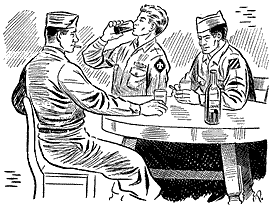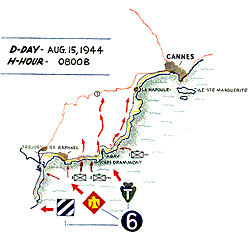|
|
|
|
VII Amphibious Assault on the Riviera |
|
| Pre-invasion fever was raging in Naples during the month of July and early August. Day
by day the fleet of destroyers, LCI's, LST's and miscellaneous amphibious craft built up
in the harbor and more barrage balloons appeared over the dock area. Via Roma was a parade
of battle famed patches that had written the early amphibious history of this war at
Casablanca, Sicily, Salerno and Anzio. There was no effort made to conceal the fact that
the 3rd, 36th and 45th Divisions were taking training under the amphibious-wise VI Corps.
Adolph Hitler's tottering Wehrmacht had an exposed and soft underbelly in Europe, and we
wanted him to know that it was going to be hit by the most veteran, hardest-hitting
amphibious Corps that the United States Army had put afloat in this war. Just off the beach at Salerno we lived under shelter halves, washed in helmets, took atebrine, cursed mosquitos and the powdered gray dust and wondered "when and where". July was a month of hard work that left no doubt in our minds as to what lay ahead. Under the hot sun of Southern Italy we had blasted beach fortifications with demolitions, blown barbed wire entanglements with bangalore torpedoes, run boat drills, loading drills, assault drills and attended schools on waterproofing vehicles. If we had any time free from training we managed to get into Pompeii and see the great ornate church and the ruins of old Pompeii or to go to Paestum and eat ice cream at the Red Cross Club. Then we moved again. Loaded on trucks, we passed through Naples to a bivouac area just north of Pozzuoli where we camped in the fruit laden orchards where the dust seemed even deeper. The only good thing about the move was that we were a little closer to Naples and or occasionally one of us received a pass into the metropolis. All the combat troops in Naples were wearing wool; the rear echelon cotton and saluting wasn't required of combat troops. Once in awhile you would see some GI wearing combat boots, wool and a Combat Infantryman Badge turn out a highball to a Lieutenant wearing wool and a Purple Heart with three or four clusters. There is an indescribable feeling of camaraderie that exists in the Infantry among men who have fought in the mud, sweated out the 88's and the burp guns together and eaten K rations day in and day out up at the front.
At the end of the last week in July we combat loaded our individual equipment. The regiment landed in a dry run just south of Guagliano and we climbed our last mountain in Italy with the base plate of an 81 mm. mortar, a 300 radio or a tripod for a "heavy" on our backs. On the night of August 9th, we were left with only the clothes on our backs; the last company jeep had gone to the waterproofing area and the kitchens were gone. This was no dry run! We loaded the morning of the 10th at Bagnoli and Pozzuoli and sailed out to Salerno and lay offshore as the invasion fleet built up around us. After loading we had no communications with the rest of the company who were not on our ship. The feeling of group solidarity narrowed down to the men on our particular craft. This narrowing process was to continue as we loaded into LCVP's a few days later. Most of our regiment was combat loaded on LST's carrying eight or ten LCVP's slung from the davits; a few LCI's carried part of the service and command echelon. At daylight on the 12th the invasion fleet moved north along the coast. We all lined the rail or climbed up in the Higgins Boats to take our last look at Italy, remembering the day we first arrived there and thinking of all the men we had left behind. Nobody made much comment about being sad at leaving Italy. As we passed the tip of the Sorrento Peninsula, a bazooka man remarked that he'd like to hear that little dark-eyed gal sing "Tunra a Sorrento" again sometime. The LST farthest to the left passed close to the shores of Capri and a Lieutenant smoking a cigarette inhaled deeply, threw the butt into the wake of the ship and murmured, "Beauty dwells there, in Capri." But mostly the comments were expressions of relief. To most of us Italy had meant hard days of fighting, mountains, mud, filth and bitterness. Italy had been an inch by inch climb up the mountainous spine of a broken, dirty and disillusioned country where the advance guard of the great avalanche of American men of arms and equipment fought a disheartening, uphill war to give America the time she needed. Italy was a land of powdered gray dust, heavily burdened orchards, scrawny animals and stretching rows of White Crosses at Salerno, San Pietro and Anzio. No, there were few of us that felt any sincere regret as we lost sight of the lava strewn side of Vesuvius and turned our gaze toward the open blue Mediterranean. Beyond lay a new task. The 141st Infantry had been designated to land three battalions abreast in the first wave of the impending invasion of Southern France, spearheading the veteran 36th Division. D Day — 15 August, 1944. H Hour — 0800B! Looming up first as great dark blotches on the water and gradually assuming shape as daylight approached were the hundreds of naval vessels around us. Here, for the first time, we saw the great invasion fleet assembled.
|
|
Copyright © 1945, 1998 141st Infantry Regiment
Association. |

 We saw a lot of the men from the 3rd and the 45th
Divisions in Naples, drank a little cognac and vino, argued with each other and promptly
attacked abreast any outsider who stuck his nose into our affairs. There was a feeling of
solidarity amongst us that comes from the philosophy "this guy has got the same tough
job ahead of him that I have".
We saw a lot of the men from the 3rd and the 45th
Divisions in Naples, drank a little cognac and vino, argued with each other and promptly
attacked abreast any outsider who stuck his nose into our affairs. There was a feeling of
solidarity amongst us that comes from the philosophy "this guy has got the same tough
job ahead of him that I have".